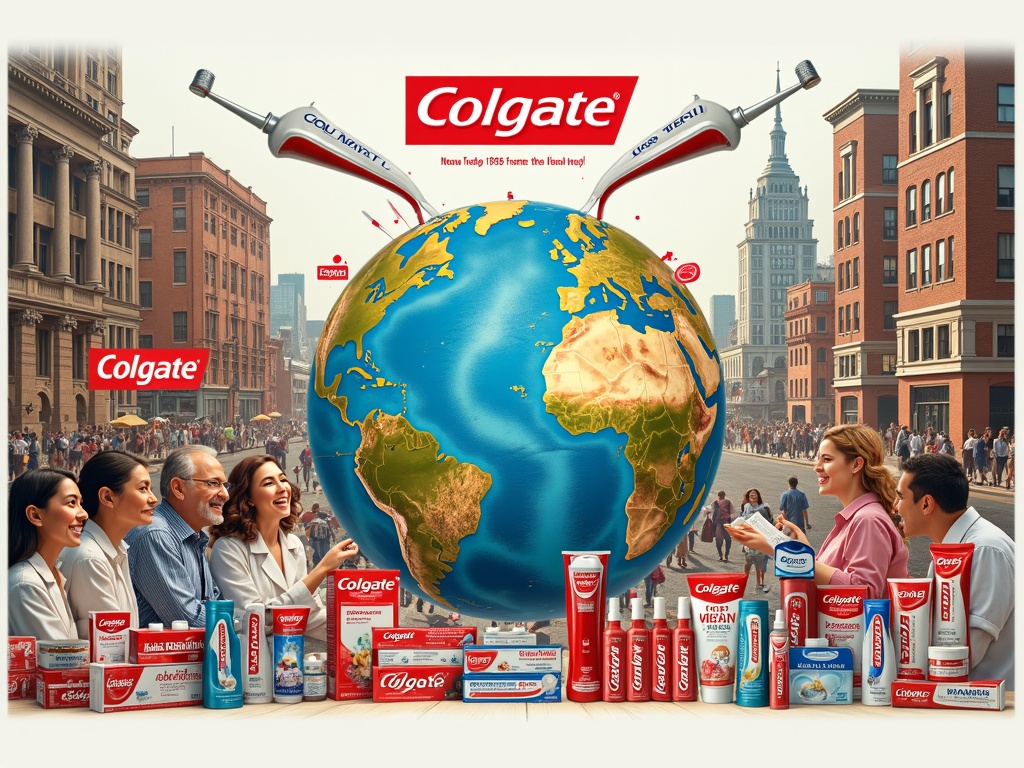No products in the cart.
Colgate Dental Care, Dental Care, Personal Care News
Find Out Who Owns Colgate Toothpaste Today
Colgate-Palmolive Company, a well-established American multinational corporation, owns the globally recognized Colgate toothpaste brand and is headquartered in New York City. As a publicly traded entity, the company operates under the ticker symbol CL on the New York Stock Exchange (NYSE), demonstrating strong market performance and leadership.
Table of Contents
Key Takeaways
- Colgate-Palmolive Company, founded in 1806, owns Colgate toothpaste and is a publicly traded corporation with institutional investors holding approximately 79-80% of its shares.
- The Vanguard Group (9.2%), BlackRock Inc. (7.8%), and State Street Corporation (4.5%) are the three largest shareholders, playing a significant role in the company’s ownership structure.
- The company operates within four main business segments: Oral Care, Personal Care, Home Care, and Pet Nutrition, with Oral Care being the largest source of revenue.
- Colgate-Palmolive reached a net sales milestone of $19.5 billion in 2023, a notable increase from $17.97 billion in 2022, and currently employs around 33,900 people globally.
- Noel Wallace has served as Chairman, President, and CEO since 2019, overseeing a diverse brand lineup that includes Tom’s of Maine, Irish Spring, Fabuloso, Ajax, and Hill’s Pet Nutrition.
You can find more about the company and its financials on its official investor relations page.
Colgate-Palmolive: The Company Behind the Iconic Toothpaste
I can tell you definitively that Colgate toothpaste is owned by Colgate-Palmolive Company, an American multinational corporation headquartered in New York City. This publicly traded company operates under the ticker symbol CL on the New York Stock Exchange, making its ownership structure completely transparent to investors and consumers alike.
Ownership Structure and Corporate Identity
Colgate-Palmolive operates as a publicly traded entity, which means thousands of shareholders collectively own the company rather than a single family or private individual controlling it. This shareholder-based ownership model provides several advantages that directly benefit consumers and the brand’s long-term stability.
The NYSE listing under ticker CL allows anyone to purchase shares and become a partial owner of the company. This democratic ownership structure creates accountability mechanisms that private companies don’t face. Quarterly earnings reports, annual shareholder meetings, and SEC filings ensure complete transparency in how the company operates and allocates resources.
I’ve observed that this public ownership model has contributed significantly to Colgate’s consistent market presence and reliable product quality. Shareholders expect steady returns, which drives the company to maintain high standards and invest continuously in research and development.
Business Operations and Market Segments
Colgate-Palmolive operates across four distinct categories that showcase the company’s diversified approach to consumer goods. These operational segments include:
- Oral Care – featuring toothpaste, toothbrushes, mouthwash, and dental floss products
- Personal Care – encompassing body care, skin care, and deodorant lines
- Home Care – covering household cleaning products and laundry detergents
- Pet Nutrition – including premium pet food brands and nutritional supplements
This diversification strategy strengthens the company’s financial position and reduces dependency on any single product category. The Colgate brand’s success in oral care has provided a solid foundation that supports expansion into other consumer product categories.
The oral care segment remains the company’s largest revenue generator and most recognizable division globally. Colgate toothpaste specifically holds dominant market positions across numerous countries, making it one of the most trusted oral care brands worldwide.
Colgate-Palmolive’s global strategy focuses on innovation and market expansion, particularly in emerging economies where oral care awareness continues growing. The company’s research facilities develop new formulations and technologies that keep Colgate products competitive against both established competitors and new market entrants.
The shareholder ownership structure reinforces long-term thinking in product development and market strategies. Unlike privately held companies that might prioritize short-term profits, publicly traded Colgate-Palmolive must balance immediate returns with sustainable growth that satisfies diverse shareholder expectations.
Manufacturing and distribution operations span multiple continents, with export operations carefully managed to meet international regulatory requirements. This global footprint supports both wholesale distribution and retail partnerships that bring Colgate products to consumers in over 200 countries and territories.
The company’s commitment to social responsibility and environmental sustainability reflects shareholder values and regulatory expectations that publicly traded companies face. These initiatives include:
- Sustainable packaging development
- Water conservation programs
- Oral health education campaigns in underserved communities
Colgate-Palmolive’s presence extends beyond retail consumers into commercial markets, including the hospitality and food service sectors where professional-grade oral care products meet institutional needs.
This comprehensive ownership and operational structure positions Colgate-Palmolive as a stable, accountable company that can adapt to changing market conditions while maintaining the quality and reliability consumers expect from the Colgate brand.

Global Powerhouse in Consumer Products
Colgate-Palmolive stands as a Fortune 500 giant that commands respect across international markets. The company achieved remarkable net sales of $19.5 billion in 2023, marking a significant increase from $17.97 billion in 2022. This financial performance reflects the strength of a business model built on consistent consumer trust and widespread market penetration.
Market Dominance and Operational Scale
The company’s reach extends far beyond typical consumer goods manufacturers, with products available in over 200 countries and territories. I’ve observed how this extensive distribution network supports their position as a toothpaste market leader, historically maintaining over 40% of the global toothpaste market share. This dominance doesn’t happen by accident—it results from strategic positioning and brand recognition built over generations.
Colgate-Palmolive’s workforce of approximately 33,900 employees demonstrates the operational complexity required to serve such a vast global market. Each employee contributes to maintaining the company’s competitive edge through manufacturing, distribution, research, and customer engagement across diverse cultural and economic environments.
The Colgate brand story reveals how consistent innovation drives their market leadership. Their approach combines traditional oral care expertise with modern consumer insights, allowing them to anticipate and respond to changing preferences across different regions. Marketing investment remains a cornerstone of their strategy, ensuring brand visibility and consumer education about oral health benefits.
Trust forms the foundation of Colgate’s decades-long leadership in oral care. Consumers rely on their products for daily health routines, creating a relationship that transcends simple transactions. This trust translates into repeat purchases and brand loyalty that competitors struggle to replicate.
The company’s global strategy focuses on maintaining market leadership while adapting to local preferences and regulatory requirements. Different regions demand specific formulations, packaging, and marketing approaches, which Colgate manages through localized operations while maintaining brand consistency.
Financial growth from 2022 to 2023 demonstrates the company’s resilience and ability to expand even in challenging economic conditions. Revenue increases of this magnitude reflect successful product launches, market expansion, and operational efficiency improvements. The company continues investing in research and development to introduce products that meet evolving consumer needs while defending their substantial market position against emerging competitors.
Who Really Owns Colgate-Palmolive?
The ownership structure of Colgate-Palmolive reveals a fascinating picture of institutional dominance that shapes how this global consumer goods giant operates. Rather than being controlled by a single family or founder, Colgate-Palmolive shareholders consist primarily of large institutional investors who collectively hold approximately 79–80% of all outstanding shares as of early 2024.
Major Institutional Shareholders
Three financial powerhouses stand out as the largest shareholders in Colgate-Palmolive’s ownership structure:
- The Vanguard Group, Inc. leads with approximately 9.2% ownership, making it the single largest shareholder.
- BlackRock Inc. follows closely with roughly 7.8% of total shares.
- State Street Corporation rounds out the top three with about 4.5% ownership.
These percentages represent billions of dollars in market value and demonstrate the confidence that major investment firms place in Colgate-Palmolive’s long-term prospects. The Vanguard Group’s position as the top shareholder reflects its massive index fund operations, where millions of individual investors indirectly own pieces of Colgate through mutual funds and ETFs.
BlackRock’s substantial stake aligns with its role as one of the world’s largest asset managers, overseeing trillions in assets across various investment vehicles. State Street Corporation’s position further reinforces the institutional investor confidence in the company’s stable cash flows and dividend-paying capabilities.
What Institutional Dominance Means
This heavy institutional ownership pattern creates several important implications for how Colgate-Palmolive operates and grows. Institutional investors typically focus on long-term value creation rather than short-term market fluctuations, which provides management with stability to execute multi-year strategic plans. These large shareholders often have significant influence over major corporate decisions through their voting rights.
The remaining 20–21% of shares belongs to individual retail investors scattered across the globe. These individual shareholders include everyone from small-scale investors buying a few shares through online brokers to wealthy individuals maintaining larger positions in their personal portfolios.
Institutional dominance also reflects strong investor confidence in Colgate-Palmolive’s financial stability and market position. Major investment firms conduct extensive due diligence before committing billions of dollars to any single company. Their continued investment in Colgate’s brand story and business model signals their belief in the company’s ability to generate consistent returns.
This ownership structure supports Colgate-Palmolive’s position as a blue-chip stock that appeals to conservative investors seeking steady dividends and modest but reliable growth. The company’s consistent dividend payments over decades have made it particularly attractive to income-focused institutional investors managing pension funds and retirement accounts.
The geographic distribution of these institutional owners spans multiple countries, though many of the largest shareholders are based in the United States where Colgate-Palmolive is headquartered and primarily listed. However, the company’s global operations and Colgate innovation global strategy attract investors from around the world who want exposure to emerging market growth through a stable, established brand.
Understanding this ownership structure helps explain why Colgate-Palmolive maintains its focus on steady, predictable growth rather than pursuing riskier expansion strategies. Institutional investors generally prefer companies that can deliver consistent performance quarter after quarter, which aligns perfectly with Colgate-Palmolive’s business model of selling essential consumer products with strong brand loyalty.

From Soap Shop to Global Brand: The Colgate Story
I find Colgate’s transformation from a humble soap shop to a multinational corporation fascinating. William Colgate established his small soap and candle business in New York City in 1806, laying the foundation for what would become one of America’s most recognizable brands. This modest beginning marked the start of a company that would eventually dominate the oral care industry.
Colgate’s first major breakthrough in dental hygiene came in 1873 when the company introduced aromatic toothpaste sold in jars. This innovation represented a significant shift from the tooth powders commonly used during that era. However, the real game-changer arrived in 1896 when Colgate launched the first toothpaste packaged in a collapsible tube. This revolutionary packaging design transformed oral hygiene practices and established a standard that remains virtually unchanged today.
The Palmolive-Peet Merger and Corporate Evolution
The company’s structure changed dramatically in 1928 through a strategic merger with Palmolive-Peet, creating the Colgate-Palmolive Company we know today. This consolidation brought together complementary product lines and expanded the company’s reach across multiple consumer categories. I’ve observed how this merger positioned Colgate to compete more effectively in the growing personal care market.
Throughout the following decades, Colgate systematically built its reputation as a trusted household name. The company’s focus on quality and innovation helped establish deep consumer loyalty that spans generations. Today’s Colgate ownership structure reflects this rich history of growth and adaptation.
The Colgate brand story demonstrates how consistent investment in research and development has driven success. From William Colgate’s original soap shop to today’s global presence, the company has maintained its commitment to improving daily hygiene routines. This evolution showcases how a simple idea can grow into an international powerhouse through strategic vision and execution.
Colgate’s journey from 1806 to the present illustrates the power of innovation in building lasting brands. The company’s ability to anticipate consumer needs and adapt its products accordingly has secured its position as a leader in oral care and household products across multiple generations.

The Brand Empire Beyond Toothpaste
Colgate-Palmolive’s ownership extends far beyond the iconic toothpaste tubes you see in every grocery store. I’ve discovered that this consumer goods giant operates an impressive portfolio spanning multiple categories that touches nearly every aspect of daily life.
Diverse Product Categories Drive Success
The company’s strategic diversification creates multiple revenue streams across four primary sectors:
- Oral Care leads with trusted names like Colgate, Tom’s of Maine, elmex, and meridol
- Personal Care includes Palmolive, Softsoap, Irish Spring, Speed Stick, and Lady Speed Stick
- Home Care features cleaning powerhouses like Fabuloso, Ajax, Murphy Oil Soap, and Suavitel
- Pet Nutrition rounds out the portfolio with Hill’s Science Diet and Hill’s Prescription Diet
This broad approach shields the company from market fluctuations that might affect any single product category. When oral care sales dip in one region, strong performance in home care or pet nutrition can maintain overall growth momentum.
The Colgate brand story demonstrates how strategic acquisitions built this empire. Tom’s of Maine brought natural personal care expertise, while the Hill’s acquisition positioned Colgate-Palmolive as a major player in premium pet nutrition. Each brand maintains its unique identity while benefiting from the parent company’s distribution network and marketing resources.
Personal care products like Irish Spring and Speed Stick leverage the same retail relationships that made Colgate toothpaste ubiquitous. This cross-category presence gives the company significant negotiating power with retailers and creates opportunities for bundled promotions.
The home care division capitalizes on different shopping patterns entirely. Fabuloso’s popularity in Latino markets and Ajax’s cleaning power create loyal customer bases that complement oral care products. These brands often occupy different shelf space, effectively multiplying the company’s retail footprint.
Pet nutrition through Hill’s represents perhaps the most strategic diversification. This sector commands premium pricing and enjoys strong veterinary endorsements. Pet owners demonstrate remarkable brand loyalty, especially for prescription diets, creating recurring revenue streams that grocery staples can’t match.
Global strategy innovation allows each brand to adapt to local preferences while maintaining core brand values. Palmolive’s formulations vary by region, Speed Stick offers different fragrances for various markets, and Fabuloso develops scents that resonate with cultural preferences.
This diversified approach ensures steady global growth by spreading risk across multiple consumer segments. Economic downturns might reduce spending on premium oral care, but home cleaning products remain essential purchases. Similarly, pet nutrition often proves recession-resistant as owners prioritize their pets’ health.
Leadership at the Helm
I’ve observed how strong leadership can make or break a global corporation, and Colgate-Palmolive exemplifies this principle with its current management structure. Noel Wallace has served as Chairman, President, and CEO since 2019, bringing decades of experience to guide the company’s strategic direction. His leadership focuses on driving growth across all product categories while maintaining the brand’s reputation for quality and innovation.
Executive Team and Strategic Direction
The company’s executive team works closely with Wallace to execute comprehensive strategies that span multiple continents and product lines. These leaders oversee key areas including:
- Research and development initiatives for new product formulations
- Global marketing campaigns that resonate with diverse consumer bases
- Supply chain optimization across manufacturing facilities worldwide
- Sustainability programs that align with environmental goals
- Digital transformation efforts to enhance consumer engagement
Each executive brings specialized expertise to their role, ensuring that decisions reflect both market demands and operational capabilities. I’ve noticed how this collaborative approach allows Colgate’s brand story to remain consistent while adapting to regional preferences and regulatory requirements.
The Board of Directors provides essential oversight, representing shareholder interests while guiding long-term strategic planning. This governance structure maintains accountability throughout the organization, from headquarters decisions to local market implementations. Board members bring diverse backgrounds in business, finance, and industry expertise, contributing valuable perspectives on market trends and risk management.
This leadership framework ensures that Colgate’s innovation and global strategy remains aligned with both immediate performance targets and sustainable growth objectives. Wallace and his team regularly communicate with investors, outlining progress on key initiatives and addressing market challenges proactively.
The current management structure has successfully maintained Colgate-Palmolive’s position as a market leader while expanding into new categories and geographic regions. Under Wallace’s direction, the company continues to invest in product development, manufacturing capabilities, and brand building activities that strengthen its competitive advantage. This leadership stability provides confidence to stakeholders and supports the company’s ability to adapt to changing consumer preferences and market conditions.

Sources:
Colgate-Palmolive Company – Corporate Website and Investor Relations
Yahoo Finance – Colgate-Palmolive (CL) Stock Profile and Holders
Forbes – Global 2000: World’s Largest Public Companies
U.S. Securities and Exchange Commission – Annual Reports and Filings (CL)


